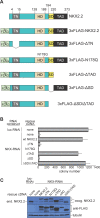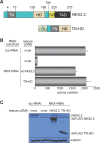EWS/FLI mediates transcriptional repression via NKX2.2 during oncogenic transformation in Ewing's sarcoma
- PMID: 18414662
- PMCID: PMC2291578
- DOI: 10.1371/journal.pone.0001965
EWS/FLI mediates transcriptional repression via NKX2.2 during oncogenic transformation in Ewing's sarcoma
Abstract
EWS/FLI is a master regulator of Ewing's sarcoma formation. Gene expression studies in A673 Ewing's sarcoma cells have demonstrated that EWS/FLI downregulates more genes than it upregulates, suggesting that EWS/FLI, and/or its targets, function as transcriptional repressors. One critical EWS/FLI target, NKX2.2, is a transcription factor that contains both transcriptional activation and transcriptional repression domains, raising the possibility that it mediates portions of the EWS/FLI transcriptional signature. We now report that microarray analysis demonstrated that the transcriptional profile of NKX2.2 consists solely of downregulated genes, and overlaps with the EWS/FLI downregulated signature, suggesting that NKX2.2 mediates oncogenic transformation via transcriptional repression. Structure-function analysis revealed that the DNA binding and repressor domains in NKX2.2 are required for oncogenesis in Ewing's sarcoma cells, while the transcriptional activation domain is completely dispensable. Furthermore, blockade of TLE or HDAC function, two protein families thought to mediate the repressive function of NKX2.2, inhibited the transformed phenotype and reversed the NKX2.2 transcriptional profile in Ewing's sarcoma cells. Whole genome localization studies (ChIP-chip) revealed that a significant portion of the NKX2.2-repressed gene expression signature was directly mediated by NKX2.2 binding. These data demonstrate that the transcriptional repressive function of NKX2.2 is necessary, and sufficient, for the oncogenic phenotype of Ewing's sarcoma, and suggest a therapeutic approach to this disease.
Conflict of interest statement
Figures





References
-
- Grier HE. The Ewing family of tumors. Ewing's sarcoma and primitive neuroectodermal tumors. Pediatr Clin North Am. 1997;44:991–1004. - PubMed
-
- Rodriguez-Galindo C, Spunt SL, Pappo AS. Treatment of Ewing sarcoma family of tumors: current status and outlook for the future. Med Pediatr Oncol. 2003;40:276–287. - PubMed
-
- McAllister NR, Lessnick SL. The potential for molecular therapeutic targets in Ewing's sarcoma. Curr Treat Options Oncol. 2005;6:461–471. - PubMed
-
- Delattre O, Zucman J, Plougastel B, Desmaze C, Melot T, et al. Gene fusion with an ETS DNA-binding domain caused by chromosome translocation in human tumours. Nature. 1992;359:162–165. - PubMed
-
- Turc-Carel C, Aurias A, Mugneret F, Lizard S, Sidaner I, et al. Chromosomes in Ewing's sarcoma. I. An evaluation of 85 cases of remarkable consistency of t(11;22)(q24;q12). Cancer Genet Cytogenet. 1988;32:229–238. - PubMed
Publication types
MeSH terms
Substances
Grants and funding
LinkOut - more resources
Full Text Sources
Other Literature Sources

